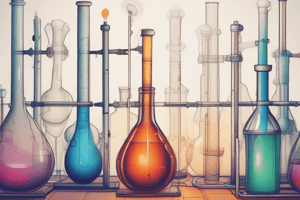Podcast
Questions and Answers
What is the purpose of the stationary phase in chromatography?
What is the purpose of the stationary phase in chromatography?
- To apply the mixture
- To separate the mixture (correct)
- To move slowly over the pure solvent
- To carry the components separately
Which term is the origin of the word chromatography?
Which term is the origin of the word chromatography?
- Write
- Colour
- Grathein
- Chroma (correct)
What is the role of the pure solvent in chromatography?
What is the role of the pure solvent in chromatography?
- To separate the mixture
- To apply the mixture
- To carry the components separately (correct)
- To move slowly over the stationary phase
Which type of chromatography technique is based on the interaction with the stationary phase?
Which type of chromatography technique is based on the interaction with the stationary phase?
What is the purpose of the mobile phase in chromatography?
What is the purpose of the mobile phase in chromatography?
What are some applications of chromatography in the chemical and life sciences industries?
What are some applications of chromatography in the chemical and life sciences industries?
Which of the following is a disadvantage of chromatography?
Which of the following is a disadvantage of chromatography?
What is the purpose of the mobile phase in chromatography?
What is the purpose of the mobile phase in chromatography?
What are the effective factors in the separation process of chromatography?
What are the effective factors in the separation process of chromatography?
Flashcards
Chromatography
Chromatography
A lab technique to separate mixtures into components for analysis, identification, purification & quantification.
Mobile Phase
Mobile Phase
The moving solvent that carries the sample through the chromatography system.
Stationary Phase
Stationary Phase
The substance that selectively adsorbs components, causing separation.
HPLC and GC
HPLC and GC
Signup and view all the flashcards
Chromatography Classification
Chromatography Classification
Signup and view all the flashcards
Principles of Chromatography
Principles of Chromatography
Signup and view all the flashcards
Applications of Chromatography
Applications of Chromatography
Signup and view all the flashcards
Advantages of Chromatography
Advantages of Chromatography
Signup and view all the flashcards
Disadvantages of Chromatography
Disadvantages of Chromatography
Signup and view all the flashcards
Study Notes
An Overview of Chromatography: Principles, Techniques, and Applications
- Chromatography is a laboratory technique used for separating mixtures into their components for analysis, identification, purification, and quantification.
- The technique involves dissolving a sample in a mobile phase (gas, liquid, or supercritical liquid) and forcing it through a stationary phase (solid or liquid particle attached to a glass or metal surface).
- The stationary phase selectively absorbs components of the mixture, separating them based on their solubility in each phase.
- High performance liquid chromatography (HPLC) and gas chromatography (GC) use narrow tubes packed with stationary phase and a continuous flow of mobile phase to separate components.
- The mobile phase can be a liquid or gas that moves the mixture down the chromatographic system, while the stationary phase remains in place.
- Chromatography is based on the principles of adsorption, fractionation, and molecular characteristics related to affinity or molecular weight differences.
- The chromatography diagram shows the wetting of the stationary phase with the solvent, addition of the sample, slow addition of the solvent mixture, and collection of separated components.
- There are different types of chromatography techniques based on the interaction with the stationary phase, physical state of the mobile phase, and chromatographic bed shape.
- Chromatography has various applications in chemical and life sciences industries, including testing water and air samples for purity, detecting toxic contaminants in oils and pesticides, and separating drugs from blood.
- Chromatography is a simple, accurate, and fast method of separating components, requiring only small sample volumes.
- However, chromatography equipment can be expensive, sensitive, and require periodic maintenance and replacement of parts.
- Some chromatography methods may also require high power consumption and operational pressure for efficient separation.
An Overview of Chromatography
- Chromatography is a technique that separates mixtures into their components for analysis, identification, purification, and quantification.
- The process involves injecting a gaseous or liquid sample into a mobile phase, usually an inert gas or nonreactive gas, and passing it through a stationary phase.
- The stationary phase can be a solid or liquid particle attached to a glass or metal surface in a column, and the surface of the solid particle can also act as a stationary phase.
- The mobile phase is the solvent that moves the mixture down to the stationary phase, and substances used as mobile phases depend on the components to be separated and the type of chromatography.
- Chromatography is based on the principle where molecules in a mixture are immobilized on a surface or in a solid, and the liquid stationary phase is separated from each other with the help of a mobile phase.
- The effective factors in this separation process include adsorption, fractionation, and molecular characteristics related to affinity or difference between molecular weights.
- There are different types of chromatography techniques classified based on the interaction to the stationary phase, physical state of mobile phase, and chromatographic bed shape.
- Chromatography has many applications in testing water and air samples for purity, determining toxic contaminants in oils and pesticides, separating drugs from the blood, and solving forensic crimes.
- The advantages of chromatography include its simplicity, ability to separate complex mixtures, detecting small amounts of sample, accuracy, requiring little sample volume, and working on a wide range of samples.
- The disadvantages of chromatography include expensive equipment, errors due to overloading of samples, requiring careful handling of equipment, requiring more solvent for some techniques, periodic maintenance and replacement of parts, and high power consumption for some methods.
- The basic principle of chromatography involves wetting the stationary phase with a solvent, adding the mixed mixture to the top of the column, and allowing the adsorption process on the silica surface to begin.
- The tap is then turned on to initiate the movement of the compounds in the mixture, based on the polarity of the molecules in the sample, with non-polar components moving at a higher speed than polar components.
Studying That Suits You
Use AI to generate personalized quizzes and flashcards to suit your learning preferences.




